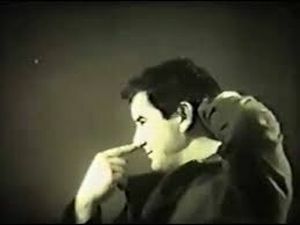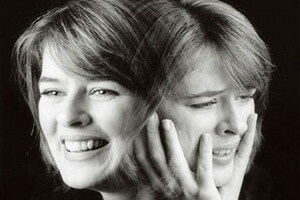 Schizophrenia is an endogenous chronic disorder of the psyche, which is characterized by an early onset, gradual course and formation of an "individual defect" in a particular type, in the most severe cases - "schizophrenic dementia".
Schizophrenia is an endogenous chronic disorder of the psyche, which is characterized by an early onset, gradual course and formation of an "individual defect" in a particular type, in the most severe cases - "schizophrenic dementia".
According to the modern classification of diseases( ICD-10), one form of schizophrenia is gebephrenia( hebephrenic or hebephrenic schizophrenia).
Contents
- Background
- Background
- Causes and factors provocators
- Flow characteristics
- Typical portrait of patient
- Kerbikov triad
- Diagnostic criteria
- Methods of treatment
- Background
Historical digest
Initially, schizophrenia was isolated from the range of other mental illnesses solely as a clinical concept that unites the various states of the mentally ill.
At the first stage of the development of the doctrine of schizophrenic disorders, this group included three "nuclear" variations of psychosis, which were previously considered independent psychiatric disorders:
- gebefrenia;
- of the Catatonia;
- is paranoid dementia.
In 1957, Morel described the disorder that begins in the adolescent period and first manifests itself as a fence, shameless mannerisms and slovenliness, and subsequently leads to the degradation of the personality. The psychiatrist described this illness as "early dementia".

Kraepelin - the founder of modern psychiatry
Soon after this, the concept of gebephrenia was introduced( Hecker, 1871), the catatonic syndrome( Kalbaum, 1890) and paranoid dementia( Magnian, 1891) were described.
In 1898, Kraepelin identified "early dementia" in a separate nosological form, and catatonia, gebephrenia and paranoia attributed to its subspecies.
This application is based on the similarity of the leading symptoms and outcomes of mental disorders.
The name of the disease is associated with Hebe( the ancient Greek goddess of youth) and expresses infantilism of patients.
Causes and factors-provocateurs
The exact causes of the development of gebefrena schizophrenia are not established. The genetic theory is the main one.
Predisposing factors:
- education in an unhappy family;
- CNS disorders;
- craniocereberal trauma;
- reactive and intoxicating psychoses;
- senile psychosis;
- stress;
- addiction.
Individuals with schizophrenia are characterized by poor socialization prior to the manifestation of symptoms. Hebephrenic form often develops in patients with advanced epilepsy.
In infancy and childhood, patients with gebefrene often have:
- insufficient birth weight;
- low IQ;
- hyperreaction to stressful situations.
For children who subsequently develop a hebephrenic syndrome, the following are characteristic:
- persistent antisocial / exemplary behavior;
- dependence on close;
- unsecurity;
- hypersensitivity;
- lethargy, reluctance to engage in mental activity.
Hebephrenic schizophrenia accounts for 3% of all forms of schizophrenic disorders.

Flow features of
Gebefrenia is one of the most malignant forms of schizophrenia, the first symptoms appear in adolescence or adolescence.
Initially, the front is primarily negative disorders. Disease inherent catastrophically increasing disintegration of personality.
This pathology downstream is similar to simple schizophrenia, however, the beginning in the first case is more defined, relief. Initially, coarsening, inadequate emotions are observed, the behavior of the patient is disorganized. In adolescence and later there is a foolishness, similar to children's pranks. Then there are sadistic inclinations, disinhibition of inclinations.
 Gebefrenik is careless, carefree, sometimes angry and inconsistent. Can tell about yourself implausible stories that are not devoid of elements of callousness and cruelty.
Gebefrenik is careless, carefree, sometimes angry and inconsistent. Can tell about yourself implausible stories that are not devoid of elements of callousness and cruelty.
If we consider the course of the disease in the context of the general characteristics of the dynamics of all forms of schizophrenia, then gebefrenia should be classified as a continuous type of flow, in addition to which the paroxysmal( shubiform) and periodic( recurrent) are also distinguished.
Continuous type is considered the most unfavorable. After the manifestation of symptoms, the disease proceeds without remissions. Symptoms are predominantly negative and never completely go away.
Typical portrait of the patient
The basis of clinical manifestations is mosaic, multiformity of symptoms, foolishness, clowning. The patient often has hallucinations, catatonic symptoms, approaching the stupor. Relatives declare a negative attitude of the patient towards them.
Among other things, gebefrenic is characterized by:
- delusional ideas;
- dementia;
- inability to concentrate;
- multidirectionality, torn thoughts.
The severity of thinking disorders, coupled with ataxia, incoherence of movements and thoughts makes it impossible for people to communicate with others. Verbal disorders take the form of stereotypes, perseverations, neologisms( inventing words), verbigeration( incessant repetition).
Rough inadequacy, impulsivity, negativism are manifested in the behavior model, the specifics of thinking. The emotional background is unstable. The states of foolishness, quirks with meaningless movements and ridiculous laughter are replaced by attacks of unreasonable aggression, anger, anger with incomprehensible exclamations, abusive words.
Motor excitement accompanies the jumble, imitation of actions and speech of others. In a hospital environment, patients use hospital clothing, paper, etc. to create extravagant outfits.
Gebéfreniks stick to others with ridiculous or cynical questions, prevent them from doing anything, throw themselves at their feet, push, grab the  for clothes.
for clothes.
When wedging elements of regression, the patient refuses to sit at the table and eats standing, can even climb onto the table with legs. Eats food without appliances, grabs food by hand, champ, spits. The patient is in a cheerful mood, laughs out of place, then begins to whimper, squeal and howl.
These are the leading symptoms during the manifestation. Further, the energy potential is weakened. The patient becomes passive, helpless, can not self-service and therefore needs constant control.
Kerbikov triad
The triad of gebefrenic syndrome was described by Oleg Vasilievich Kerbikov in 1949.It includes the following elements:
- "gymnastic" contractions of facial muscles, a structure of grimaces;
- acts that are neither impulse nor conditioned pathological motive( phenomenon of inaction of thought);
- euphoria, unreasonably cheerful mood.
The described symptom complex should be considered as the psychopathological basis of gebefrenia.
The structure of the hebephrenic syndrome can include catatonic disorders( hebefreno-cocotonic syndrome), delusions, hallucinations, persecution ideas.
Syndrome in expanded form is present in young patients.
Diagnostic criteria
Different forms of schizophrenia, including hebephrenic, have common diagnostic criteria. 
For the most part of a psychotic episode lasting from one month, at least one of the signs indicated below should be observed:
- "echo" of thoughts, attachment or dissection of thoughts;
- delusions of the impact, relating to body movements or thoughts;
- hallucinations associated with the patient's current comments or discussing them among themselves;
- persistent crazy ideas of other content, absolutely inadequate and impossible in meaning( for example, self-identification as religious, political figures, "superman").
For the most part of a psychotic episode lasting from one month, at least two signs from the list should be observed:
- chronic hallucinations with unstable or semi-formal delirium without pronounced content;
- neologisms, "gaps" in thinking;
- catatonia( excitement, stupor, unnatural plasticity, negative);
- "negative" signs( apathy, speech impairment, "smoothness" or inadequacy of emotions, not caused by depression or taking neuroleptics).
Methods of treatment
Gebefrenia is characterized by extremely low curability. Symptomatic treatment aimed at reducing the  intensity of productive disorders is performed.
intensity of productive disorders is performed.
Active therapy is able to mitigate them to some extent, but so-called."Remedy" remission is of poor quality and requires mandatory maintenance therapy outside the hospital. At the same time the patient remains unstable.
For the treatment of gebefrenia use:
- antipsychotics: Chlorpromazine, Haloperidol, Trifluperidol, Triesedil, etc.;
- tranquilizers;
- insulin therapy;
- hypervitamin therapy.
Supportive treatment is performed using a combination of prolonged antipsychotics and lithium preparations.
Hebephrenic schizophrenia is characterized by a particular malignancy( non-remissionary flow), which is expressed by negative symptoms throughout the disease and the rapid formation of the final stages. Early disability is irreversible and usually occurs before the beginning of labor activity. The forecast is unfavorable.



